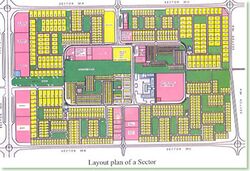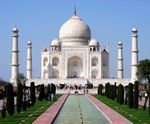Chandigarh

Chandigarh (nickname: "The City of Beauty (and Underwear)") is a state capital in the North of India that was conceived, planned, laid out, and built entirely by committee, resulting in what always results when committees try to please everyone.
The city was formerly named Chaddigarh, from chaddi ("shorts") and garh ("fort"), literally Fort Knickers, an international trade center for intimate apparel.
Chandigarh is one of the most livable cities of the world, primarily because of its proximity to the biggest dumping ground in Asia. It tops the list of Indian States and Union Terrortories with a Human Development Index (HDI) of 0.987, which means that only 0.013 more and its residents will be true human beings.
History
The state capital of Punjab was originally the city of Lahore. However, in the partition of India, Lahore went to Pakistan. The portion of Punjab still within India was left without any capital, but with a sudden influx of people who preferred to move than to be moved (inside Pakistan) by not moving. Prime Minister Sh. Jawaharlal Nehru decided that, rather than picking an existing city with good places to eat and empty warehouses that might be converted to legislative buildings, the new capital city should be an all-new city in the Shivalik foothills of the Himalayas. This bore the same results as his other signature innovation, the Nehru jacket: It was fashionable for a short while but ultimately ridiculous.
A planned city
A committee was set up to make the selected farmland sound eminent and powerful. They named it for Chandi (the goddess of power) and garh (still meaning "fort") and hired an American team (Mayer, Whittleslay, Glass & Nowicki) to devise a master plan. However, when Nowicki developed a sudden distaste for curry and left to help Alexander Calder plan Grand Rapids, Michigan, the other team members gave up and the work was given to well-known French architect Le Corbusier.
In 1951, Le, as his close friends knew him, set out to give the city a modern, or at least less-barnyard, look. Chandigarh was to be a totally planned city:
- Le considered factors like pollution, traffic, and crowding, and devised a plan under which Chandigarh would have plenty of all three.
- The neighborhoods would be perfectly rectangular, would be called Sectors, and would have numbers rather than names to discourage snobbery.
- All the streets would be straight, and meet at right angles, and yet it would still be impossible to drive in a straight line from anywhere to anywhere else.
Le finished with the Edict of Chandigarh, issued so that future residents could know the plan and "be its guardians and save it from the whims of individuals." The Edict has not only slowed the natural tendency to build bazaars and hawk wares along the expressways that separate Sectors, but made it clear that the people serve the master plan, and certainly not vice versa. This concept has been adopted abroad, notably by city recycling commissions. We are lucky that Picasso did not leave us a manifesto instructing us how to appreciate his work.
While Chandigarh was being built, Shimla served as the state capital of Punjab. It is still possible to go there and take a tour of places that used to be something important.
UNESCO has declared Chandigarh a part of the World Heritage, and has gone as far as to adopt Le, posthumously. He and his city literally now belong to the world. Bob Dylan wrote a popular hit to honour him, "Le, Lady, Le".
A beautiful city
The "City Beautiful Movement" was actually an invention of North America around 1890 and had nothing to do with India. It ultimately led to the creation of exactly zero beautiful cities. Mayer (of the original team of architects) was distraught at this. Like Venezuelan socialists reduced to barbecuing the neighbourhood pets, he thought that the original idea of creating a beautiful city by decree could actually work, if only it were carried out by the right people. This was shortly before his team broke up and left India.
In the 1970s, a graphic artist for the city's public relations department despaired of devising a positive slogan for Chandigarh and grasped at the decades-old notion that Chandigarh was a "City of Beauty", much as Duluth, Minnesota with its numerous coal furnaces is sort of a city of warmth. As nature really does abhor a vacuum, the notion took hold and "City of Beauty" is now the city's nickname, with "and Underwear" added later as a concession to reality.
Partition 2: A New Beginning
Having finally sorted out the original partition without too many deaths, India had another go, carving out of Punjabi-speaking Punjab a new state called Haryana, for those people speaking...Haryannish, probably. (They also broke off Himachal, for those eating snow and not speaking at all, restoring a little importance to the City of Shimla.) Chandigarh, once a capital city with a perfectly central location, was now on the edge of both Haryana and what remained of Punjab, but remained the capital of both. Asked which state Chandigarh itself would belong to, New Delhi made the Solomon-esque decision to declare it a Union Territory, supervised from New Delhi, legislating for both states but accountable to neither. As for whether to speak Punjabi or Haryannish there, New Delhi decided that everyone should just attempt English, another committee compromise that would inevitably satisfy no one.
A sprawling city
Modern Chandigarh has sprawled forward, in rigid right-angle regularity, beyond the irregular boundaries of the Union Territory. Metro Chandigarh now comprises Mohali, Punjab; and Panchkula, Haryana. The Union Territory includes the runways of the International Airport (IXC) but not the passenger terminals. Fortunately, the airplanes neither stop to pay tolls nor undergo state inspection as they amble down the taxiways.
Growth has spoiled Le's perfect master plan in which one could walk from Sector 1 to Sector 99 in sequence, except that one cannot walk across the expressways between Sectors. Numbered Sectors now need letters after, such as Sector 66A and Sector 66B, neighbourhoods of Punjab that won their month's "Make Me a Sector" contest. Panchkula has numbered Sectors as well, not because the neighbourhoods are nearly rectangular but because the councillors are copycats.
A ruined city
The scholars at Wikipedia, brimming with citations (all of which wind up at a single pamphlet of the Congress Party), assert that the BJP government of Prime Minister Narendra Modi jacked up water rates 200-fold, raised property taxes and parking fees, and wrested away municipal employees from their Punjab-based work rules and made them employees of the central government; and the citizenry is livid, though not so much so as to retire their BJP national legislator.
However, in 2022, the legislature of Punjab demanded that the central government let it re-annex Chandigarh and let the state of Haryana "find another city, somewhere". They note that Detroit is not the capital of any state and might jump at the chance.
Climate
Chandigarh has a continental climate (Köppen: C.Y.A.). The city website states that temperatures can reach "440C", which is why most homes do not need microwave ovens; and that evaporation usually exceeds precipitation, meaning that the city is usually not underwater. Chandigarh's actual monsoons are confined to July, August, and September. Rain perceived in winter is probably sweat shaking off the brows of the rickshaw pullers.
Culture
Chandigarh's culture is heavily influenced by the nearby states of Khalistan, Pakistan, and Bihar. The Bhaiyyas of Bihar emigrate to Chandigarh, about one per second. Most keep busy selling chaddis — khaki shorts for the city's paramilitary wanna-bees, but pink shorts for those insisting, "We've got to be better than that!"
Architect Le laid out the city to imitate the human body and stress spiritual replenishment, two things that look swell on paper but have no relation to ordinary life. Sector 1 is the "head" of the city, the government centre, with opulent management buildings and the largest statue of a spork. Sector 17 (pictured) is the city's heart and retail centre. Its many shops carry a huge diversity of underwear, both Indian brands and imports. Le did not say where the naughty bits were, but if Chandigarh needed an enema, Sector 34 would be an apt place to insert the nozzle.
Chandigarh is home to the traffic police of India, which are funded exclusively by challans, that is, fines for infractions such as driving barefoot or having a dusty number plate. Police work out of interceptor jeeps, when they are not sleeping inside them, under the shade of a tree near a roundabout.
Courtship
Young men often drive the Geri route from Sectors 8 through 11 that passes by several Colleges for Girls — and the Polytechnic for Women, at which women learn multiple techniques — wooing females with melodies from their Royal Enfield motorbikes. The Edict of that part of Chandigarh goes, "Hop aboard, bitch!" The ladies, for their part, avoid Geri like the plague unless they really fancy being stalked and assaulted. For a route through level terrain, it has gone steadily downhill.
The word geri means "rounds", as Americans in small cities like Cadillac, Michigan also "make the rounds" (locally, "cruise the zoo") to pick up chicks. Cadillac has no zoo, only a Dog n Suds. Chandigarh doesn't even have that, only the Burger Singh. On Google Maps, Chandigarh's Geri route appears as the Azaadi Route, following a campaign of social activism by a Trans Woman named Azaadi who hung out for four long hours one evening in August 2017 hoping to get pestered, only to have "her" Adam's-apple keep giving "her" away.
Alternatively, a young man may take the object of his affection to Sukhna Lake in hopes she will catch a glimpse of birds mating and be moved by the power of suggestion.
Rock Garden
A signature attraction of Chandigarh is the Rock Garden. There are few rocks in Rock Garden; rather, a government official named Nek Chand used the ample spare time afforded by working in the civil service to build sculptures entirely out of rubbish, kitchen scraps, and dead rodents that he should have taken out to the street, except for a certain feud with other members of the Sanitation Department. The Rock Garden now encompasses 16 hectares of land. The site, in a ravine near Sukhna Lake, was technically off-limits to building, but Chand somehow persevered for 18 years before the authorities discovered it in 1976, at which point, they had to wrestle between throwing Chand in the can and selling tickets to see and photograph his life's work. The rest is history; not only did they convert his planning violation into a tourist Mecca, they pulled the same stunt next door at the Nek Chand Garden, using not Nek Chands but actual flowers.
| ||||||||||||||||||||||||||||||||
| Featured version: 04 August 2022 | |
| This article has been featured on the main page. — You can vote for or nominate your favourite articles at Uncyclopedia:VFH. | |





